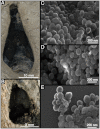Direct chemical evidence for eumelanin pigment from the Jurassic period
- PMID: 22615359
- PMCID: PMC3387130
- DOI: 10.1073/pnas.1118448109
Direct chemical evidence for eumelanin pigment from the Jurassic period
Abstract
Melanin is a ubiquitous biological pigment found in bacteria, fungi, plants, and animals. It has a diverse range of ecological and biochemical functions, including display, evasion, photoprotection, detoxification, and metal scavenging. To date, evidence of melanin in fossil organisms has relied entirely on indirect morphological and chemical analyses. Here, we apply direct chemical techniques to categorically demonstrate the preservation of eumelanin in two > 160 Ma Jurassic cephalopod ink sacs and to confirm its chemical similarity to the ink of the modern cephalopod, Sepia officinalis. Identification and characterization of degradation-resistant melanin may provide insights into its diverse roles in ancient organisms.
Conflict of interest statement
The authors declare no conflict of interest.
Figures




References
-
- Schweitzer MH. Soft tissue preservation in terrestrial mesozoic vertebrates. Annu Rev Earth Planet Sci. 2011;39:187–216.
-
- Briggs DEG, Evershed RP, Lockheart MJ. The biomolecular paleontology of continental fossils. Paleobiology. 2000;26:169–193.
-
- Ito S. High-performance liquid-chromatography (HPLC) analysis of eu- and pheomelanin in melanogenesis control. J Invest Dermatol. 1993;100:S166–S171. - PubMed
-
- Simon JD, Peles DN. The red and the black. Acc Chem Res. 2010;43:1452–1460. - PubMed
-
- Dadachova E, et al. The radioprotective properties of fungal melanin are a function of its chemical composition, stable radical presence and spatial arrangement. Pigment Cell Melanoma Res. 2008;21:192–199. - PubMed
Publication types
MeSH terms
Substances
LinkOut - more resources
Full Text Sources
Other Literature Sources

